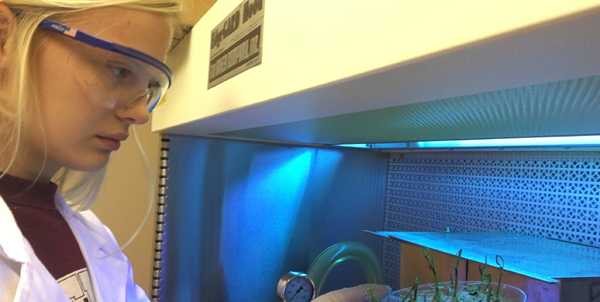
Maize on mars: Making “the martian” a reality
Surrounded by a red rocky surface as far as the eye can see, you look up and gaze at the planet Earth in the distance. Your stomach growls and you realize it is time for dinner. Heading back to your colony, you harvest some corn from your garden and prepare it to eat.
Raegan Hoefler, a senior in genetics, from New Vienna, Iowa, conducted a study to see if this garden scenario on Mars is a possibility. Hoefler received a research grant from the Iowa Space Grant Consortium to conduct an experiment inspired by the movie “The Martian.” She worked with Thomas Peterson, professor of genetics, development and cell biology and Pioneer Chair in Maize Molecular Genetics on the project.
Her research efforts also earned her a $5,000 scholarship from the consortium— a part of NASA’s National Space Grant College and Fellowship Program. “I had to design my own research and read a lot of primary literature to find out what has already been done in this field,” Hoefler says. “I learned a lot about radiation and space.”
Hoefler’s research tested the effects of radiation levels on corn, a plant that might one day be grown in a Mars colony. Her project involved exposing corn seedlings to radiation levels similar to what would be found on Mars. In the movie, based on the book “The Martian,” a man is left behind on Mars after a space mission. The only way he can survive is to cultivate potatoes.
“When people think of NASA, I don’t think growing food to sustain life on Mars comes to mind,” Hoefler says. “It also is interesting that our own ozone is depleting, so Earth may one day become more Martian-like. So we’re seeing if plant growth under these conditions is possible.”
The corn plants were exposed to both ultraviolet and x-ray irradiation. Hoefler administered UV radiation by using a germicidal lamp in the lab. The X-rays took place at the Mary Greeley Medical Center with a linear accelerator, which is used to provide radiation treatments to cancer patients.
Hoefler determined maize plants are able to survive and reproduce after being irradiated at the tested level. She also studied irradiation thought to activate transposable elements inside the corn genome. Transposable elements are sections of DNA that have the capability to copy themselves and move around within the genome. Transposable elements are usually kept inactive by the defense mechanisms of the host plant.
In the next step of research, she will conduct bioinformatics analyses to determine if transposable elements are activated in the irradiated plants. If so, the movement of the transposable elements in the genome could cause new mutations and loss of vigor.
After graduation, Hoefler is planning to pursue a doctorate in a field related to genetics or bioinformatics.



